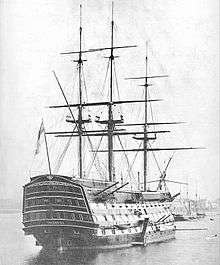Fifth-rate
In Britain's Royal Navy during the classic age of fighting sail, a fifth rate was the penultimate class of warships in a hierarchical system of six "ratings" based on size and firepower.
Rating
The rating system in the British (originally English) Royal Navy as originally devised had just four rates, but early in the reign of Charles I the original fourth rate (derived from the "Small Ships" category under his father, James I) was divided into new classifications of fourth, fifth, and sixth rates. While a fourth rate was defined as a ship of the line, fifth and the smaller sixth-rates were never included among ships-of-the-line. Nevertheless, during the Anglo-Dutch Wars of the 17th century, fifth rates often found themselves involved among the battle fleet in major actions. Structurally, these were two-deckers with a complete battery on the lower deck, and fewer guns on the upper deck (below the forecastle and quarter decks, usually with no guns in the waist on this deck).
The fifth rates at the start of the 18th century were small two-deckers, generally either 40-gun ships with a full battery on two decks, or "demi-batterie" ships, carrying a few heavy guns on their lower deck (which often used the rest of the lower deck for row ports) and a full battery of lesser guns on the upper deck. However, the latter were gradually phased out, as the low freeboard (the height of the lower deck gunport sills above the waterline) meant that it was often impossible to open the lower deck gunports in rough weather. The 40-gun (or later 44-gun) fifth rates continued to be built until the later half of the 18th century (a large group were built during the American War of Independence). From mid-century, a new fifth-rate type was introduced: the classic frigate, with no gun ports on the lower deck, and the main battery of from 26 to 30 guns disposed solely on the upper deck, although smaller guns were mounted on the quarterdeck and forecastle.
Fifth-rate ships served as fast scouts or independent cruisers and included a variety of gun arrangements. The fifth rates of the 1750s generally carried a main battery of twenty-six 12-pounders on the upper deck, with six 6-pounders on the quarterdeck and forecastle (a few carried extra 6-pounders on the quarterdeck) to give a total rating of 32-guns. Larger fifth rates introduced during the late 1770s carried a main battery of twenty-six or twenty-eight 18-pounders, also with smaller guns (6-pounders or 9-pounders) on the quarterdeck and forecastle. Tonnage ranged from 700 to 1450 tons, with crews of 215 to 294 men.
To be posted aboard a fifth-rate ship was considered an attractive assignment. Fifth rates were often assigned to interdict enemy shipping, offering the prospect of prize money for the crew.
Fifth-rate frigates were considered useful for their combination of maneuverability and firepower, which, in theory, would allow them to outmaneuver an enemy of greater force and run down one of lesser force. It was for this reason that frigates of this sort were commonly used in patrol and to disrupt enemy shipping lanes much as heavy cruisers would later in history.
Bibliography
- Rodger, N.A.M. The Command of the Ocean, a Naval History of Britain 1649-1815, London (2004). ISBN 0-7139-9411-8.
- Bennett, G. The Battle of Trafalgar, Barnsley (2004). ISBN 1-84415-107-7.
- Winfield, Rif, British Warships in the Age of Sail: 1603-1714, Barnsley (2009) ISBN 978-1-84832-040-6; British Warships in the Age of Sail: 1714-1792, Barnsley (2007) ISBN 978-1-84415-700-6; British Warships in the Age of Sail: 1793-1817, (2nd edition) Barnsley (2008). ISBN 978-1-84415-717-4; British Warships in the Age of Sail: 1817-1863, Barnsley (2014) ISBN 978-1-84832-169-4.
